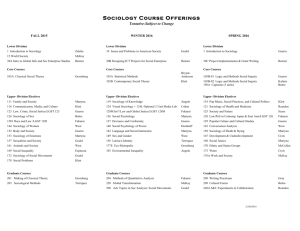Press Release: Bettie Page Obituary Los Angeles, December 11
advertisement
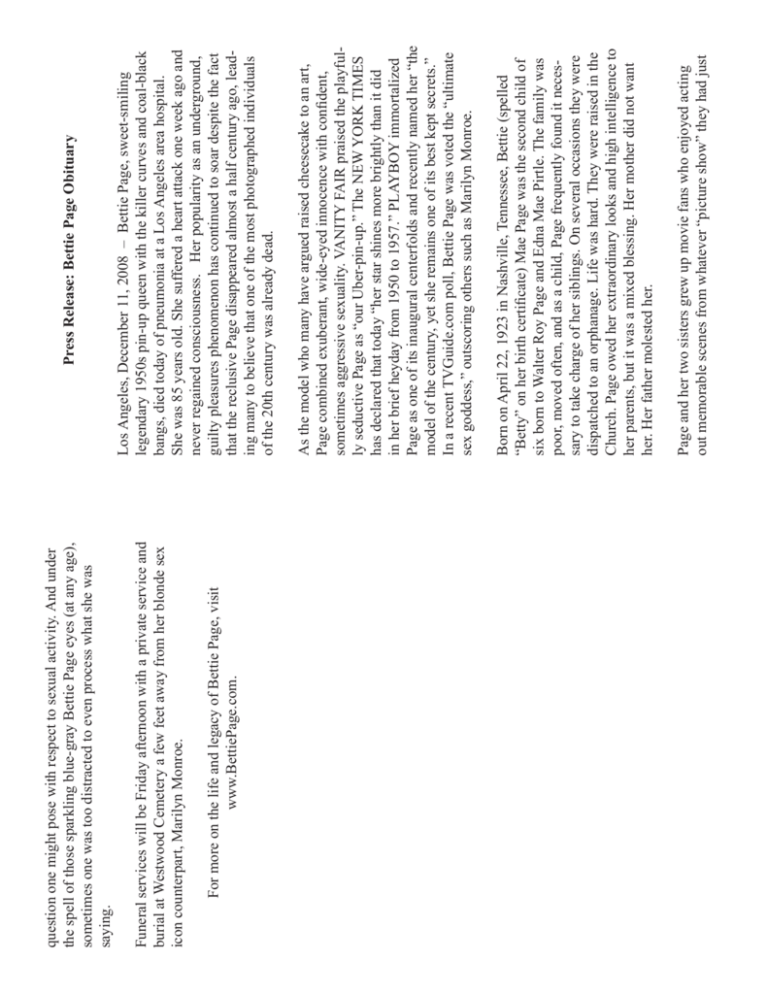
For more on the life and legacy of Bettie Page, visit www.BettiePage.com. Funeral services will be Friday afternoon with a private service and burial at Westwood Cemetery a few feet away from her blonde sex icon counterpart, Marilyn Monroe. question one might pose with respect to sexual activity. And under the spell of those sparkling blue-gray Bettie Page eyes (at any age), sometimes one was too distracted to even process what she was saying. Page and her two sisters grew up movie fans who enjoyed acting out memorable scenes from whatever “picture show” they had just Born on April 22, 1923 in Nashville, Tennessee, Bettie (spelled “Betty” on her birth certificate) Mae Page was the second child of six born to Walter Roy Page and Edna Mae Pirtle. The family was poor, moved often, and as a child, Page frequently found it necessary to take charge of her siblings. On several occasions they were dispatched to an orphanage. Life was hard. They were raised in the Church. Page owed her extraordinary looks and high intelligence to her parents, but it was a mixed blessing. Her mother did not want her. Her father molested her. As the model who many have argued raised cheesecake to an art, Page combined exuberant, wide-eyed innocence with confident, sometimes aggressive sexuality. VANITY FAIR praised the playfully seductive Page as “our Uber-pin-up.” The NEW YORK TIMES has declared that today “her star shines more brightly than it did in her brief heyday from 1950 to 1957.” PLAYBOY immortalized Page as one of its inaugural centerfolds and recently named her “the model of the century, yet she remains one of its best kept secrets.” In a recent TVGuide.com poll, Bettie Page was voted the “ultimate sex goddess,” outscoring others such as Marilyn Monroe. Los Angeles, December 11, 2008 – Bettie Page, sweet-smiling legendary 1950s pin-up queen with the killer curves and coal-black bangs, died today of pneumonia at a Los Angeles area hospital. She was 85 years old. She suffered a heart attack one week ago and never regained consciousness. Her popularity as an underground, guilty pleasures phenomenon has continued to soar despite the fact that the reclusive Page disappeared almost a half century ago, leading many to believe that one of the most photographed individuals of the 20th century was already dead. Press Release: Bettie Page Obituary been to see. “I’ve been a movie hound my whole life,” Page said. “That’s how I started learning to pose, when my little sisters asked me to mimic photos of movie stars we’d seen in the magazines and newspapers.” They would experiment with different hairdos and makeup styles. At an early age Page learned to sew at the local community center; it was a skill with a practical application years later when she designed and made her own costumes, lingerie and bikinis to wear while modeling. She was the salutatorian of her high school graduating class. She was also program director of the dramatics club, secretary-treasurer of the student council, co-editor of the school’s newspaper and yearbook, and voted “Most Likely to Succeed” by her classmates. Her own mother’s jealousy cost Page a scholarship to Vanderbilt University. Instead she earned a 1944 Bachelor of Arts degree in education from Peabody College in Tennessee. It was an uncommon achievement for a woman at that time. She tried teaching school, but her heart-breaking good looks made it impossible for the kids in class to focus on anything else but their pretty teacher. “I couldn’t control my students,” she would say with an irresistible wink, “especially the boys!” Two decades later Page returned to Peabody to work on her master’s degree. There wasn’t anyone anywhere quite like Bettie Page. She thought for herself. She chartered her own course. She was independent. Page was completely self made, bore no prejudice of any kind, and recognized no barrier to personal fulfillment. Always a free spirit, she moved from Tennessee to San Francisco, took her first of several secretarial jobs, but dreamed of movie stardom (her favorites were Bette Davis and Gregory Peck). Plus she hoped for a chance at modeling. In her first work before still cameras, Bettie Page was more than fully clothed; she wore fur coats. Everywhere she went, whatever she did, people were distracted and dumbstruck by her looks -- the beguiling smile, the raven hair, the flawless figure. Finally in 1945 one of these people arranged for the acting hopeful to visit Hollywood, where, unfortunately, 20th Near the end, she hoped people would remember her as she looked when she was young, and for being someone who, in her words, “changed people’s perspectives concerning nudity in its natural form. Being nude was something I enjoyed, it felt so natural. There is nothing disgraceful concerning nudity unless one is being promiscuous about it. Don’t forget the Bible says when God created Adam and Eve, they were stark naked. Who can argue with that?” Bettie Page was married and divorced three times, bore no children, and of her five brothers and sisters, is survived by Jack Page of Nashville, Tennessee, and Joyce Page of Atlanta, Georgia. When Bettie Page left the modeling scene, she sought privacy, read widely, enjoyed classic movies, mastered fields which interested her (including homeopathic medicine and nutrition), and lived out her life as a devoted Christian. Many times she told friends, “My long term goal is to live a healthy hundred years.” She made occasional visits to the Playboy Mansion to watch old movies and attend private parties with her friend Hugh Hefner and her agent, Roesler. She was humbled at all the attention she got five years ago, when she attended Playboy’s 50th Anniversary party at the Playboy Mansion with Anna Nicole Smith. Both Smith and Page made a grand entrance and enjoyed the special attention they received. That evening they were photographed together in what was said to be the only time in the past 50 years that Page allowed her photograph to be taken. Her story is an impossible incursion of near misses, bad luck, contradictions and lost opportunities. Page was strong-willed, and fiercely independent. She battled long and hard against both physical and mental illnesses. From the 1950s and beyond, when strangers would recognize her, she would deny her identity. “Bettie Page?” she would respond, “Who is that?” And yet to friends, she always told the truth, and would candidly (and sometimes endlessly!) discuss any aspect of her long life, including any conceivable prolific. Almost immediately she was the ubiquitous face and figure adorning such publications as WINK, EYEFUL, SIR!, HE, SHE, JEST, BARE, STARE, GAZE, VUE, TITTER, SUNBATHING, BEAUTY PARADE, CHICKS AND CHUCKLES and scores more. Her saucy pictures ripped from these magazines decorated offices, lockers, garages and all manner of rooms around the world as if they constituted a new Bettie Page brand of wallpaper. Her image was everywhere, and attracted international attention and notoriety. In posing for such photos (some by acclaimed fashion photographer Bunny Yeager), many who were witnesses recall that Page seemed to command these sessions the way a movie director would. Without intending to (and without realizing it either), because of her ingenuity and dominant personality, Page was effectively the creative force controlling much of her own work. “I was generally happy posing, and that seemed to shine through in the pictures,” Page explained. “Nobody knew this, but I used to imagine the camera was my boyfriend, and I was making love to him. I had fun teasing the guy with the camera until he was in sync with whatever mood I was in.” At a time when Marilyn Monroe was studying at the Actors Studio in Manhattan, Page was doing the same at the renowned Herbert Berghof Studios only blocks away. “I wasn’t trying to be an actress at that time, but I wanted to see if I could really act or not.” The answer was pretty much, no. Actor Robert Culp taught some of Page’s classes, and did a dramatic one-act play with her. The title was DARK LADY OF THE SONNETS. “She was in way over her head,” Culp remembered. “She was nice, but she was not an actress, and had she continued, her thick Southern accent would have been a problem for her.” Berghof and his wife, Uta Hagen (both famous exponents of the Stanislavsky method of acting) were impressed by one scene, however, and asked Page what she was drawing upon from her own them both. She was confident her audience did as well. Hugh Hefner says the appearance of Bettie Page in PLAYBOY was a milestone, and that “she became, in time, an American icon, her winning smile and effervescent personality apparent in every pose. A kinky connection was added by Irving Klaw’s spanking, fetish and bondage photos, which became part of the Bettie Page mystique; they were playful parodies that are now perceived as the early inspiration for Madonna’s excursions into the realm of sexual perversion.” The fashion designers, Madonna, and others can copy the fetish behavior, the bangs and the bullets bras, but only the spontaneous and unpredictable Bettie Page herself was able to project the unique and volatile combination of the playful nice girl -- along with the perilous one. Wholesome innocence one moment, dangerous dominance the next. That quality defined the Bettie Page persona, as well the flesh and blood person few people were fortunate enough to know. Quietly, steadily, old black and white photos of Bettie Page have continued to stimulate tributes in the form of books, websites, fan clubs, documentary films, and countless licensed products. Two examples of how Bettie Page has been re-introduced to new generations of eager young fans: First, Dave Stevens created a comic book hero called “The Rocketeer,” with a love interest clearly inspired by Bettie Page; Disney adapted it as a big budget, samenamed motion picture vehicle for Oscar-winning actress Jennifer Connelly. Stevens, recently deceased, became one of Page’s most devoted friends, one of the few she could trust. It was Stevens who escorted Bettie Page to the Playboy Mansion for a private 35mm screening of THE ROCKETEER in 1994. She had never seen the film before. She loved it. Second example: the noted erotic pin-up artist Olivia, who has been painting Bettie Page for a quarter century (in art books, for PLAYBOY, on limited edition posters, etc.), was the first to successfully integrate her fetish imagery for a high fashion licensee, Fiorucci “You couldn’t walk by a newsstand without seeing a picture of this gal on one magazine or another,” said Hillard Elkins, who for a time represented the aspiring actress on behalf of the William Morris Agency. Without imagining the consequences on any conscious level, Page eventually found that her provocative images violated all manner of sexual taboos during that more Puritanical time, finally invoking a United States Senate Committee investigation into pornography. She was subpoenaed to appear in a Capitol Hill courtroom presided over by Senator (and presidential hopeful) Estes Kefauver, yet was never called upon to actually testify. Then by 1958 this young and beautiful pin-ultimate pin-up queen was gone – suddenly vanished from view in the prime of her life. Just like Greta Garbo, like James Dean, like Jean Harlow. Gone. Except that the departure of Bettie Page was a mystery. Where and why did she go? Had she died? Was she hiding? Was she incapacitated? No one knew. Page’s disappearance only served to power her notoriety. Fantastic rumors abounded. For decades, fans searched. Even the hard-hitting investigative television program 60 MINUTES tried doing a story. It took until the mid-1990s before the truth was finally revealed. While battling some fierce inner demons, Page had secretly fled New York for Florida. In 1958 she underwent a religious epiphany. She totally retreated from the public eye, tried marriage again, and gave her life to Jesus Christ as a born-again Christian, working for Billy Graham’s ministry, among others. Incredibly, as yet another riddle in her complicated stranger-than-fiction life, during this time Page remained completely oblivious of her own profound impact upon America’s fast-changing sexuality and pop culture, not to mention the thriving cottage industry that had arisen around her celebrated image – the issuance of commercial products including Bettie Page action figures, calendars, comic books, lighters, incense, towels, DVDs, T-shirts, key chains, playing cards, lunch boxes, websites, and all manner of memorabilia. IT WAS BETTIEMANIA. The failure of Page’s third marriage in 1978 precipitated some mental instability, violent mood swings, and serious trouble with the law. The sordid details of these travails are no secret and have now been disclosed in books and the tabloid press. At last in 1992 she left San Bernardino’s Patton State Hospital to emerge from this dark period during which she had been diagnosed as a paranoid schizophrenic. Page was living quietly in seclusion in Los Angeles when she discovered her enormous niche market popularity. Playboy’s Hugh Hefner introduced Page to a Midwest lawyer who is credited with establishing the merchandising and licensing business opportunities for many of the famous icons of the 20th Century. Roesler’s company, CMG Worldwide, was representing several hundred famous personalities, most of whom were deceased, such as Marilyn Monroe, James Dean, Babe Ruth, Malcolm X and others. Roesler quickly turned the reclusive beauty into a “brand” recognized around the world. Clothing lines that featured the “Bettie Page” brand sprung up, as did a store called “Bettie Page” on the Las Vegas Strip. Page became increasingly popular not only here in the United States, but throughout the world. Her website www. BettiePage.com became one of the most heavily trafficked sites on the internet, getting almost ¾ million hits each day. “She was a remarkable woman,” Roesler reflected, “truly someone that changed the social norms, not only here in this country, but also around the world. While Jackie Robinson was changing the racial attitudes, Bettie Page was changing our attitudes on sex. She became a James Dean type of ‘rebel’ figure as she allowed people to be less inhibited and look at sex in a different way. “ Roesler said her influence will be on the same level as a Marilyn Monroe. “Her undeniable influence will forever remain in fashion, films and merchandising,” Roesler declared. “She was reclusive and private, so without intending to be, without quite understanding how, her modeling work made her a pivotal figure in the sexual revolution that began in the 1950s. I was always flattered by Bettie’s


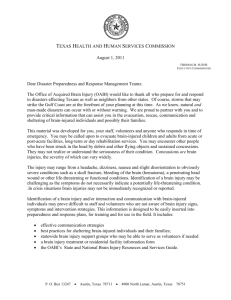

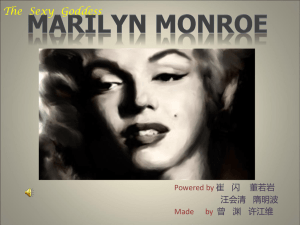
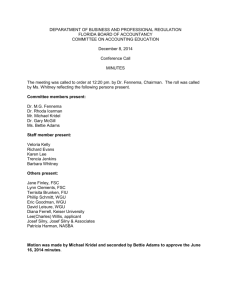
![[SOC 3AC] Niyogi F13 Midterm Exam](http://s3.studylib.net/store/data/008024599_1-cec01b60ef2f28fd40035e6e0b60c3ca-300x300.png)
